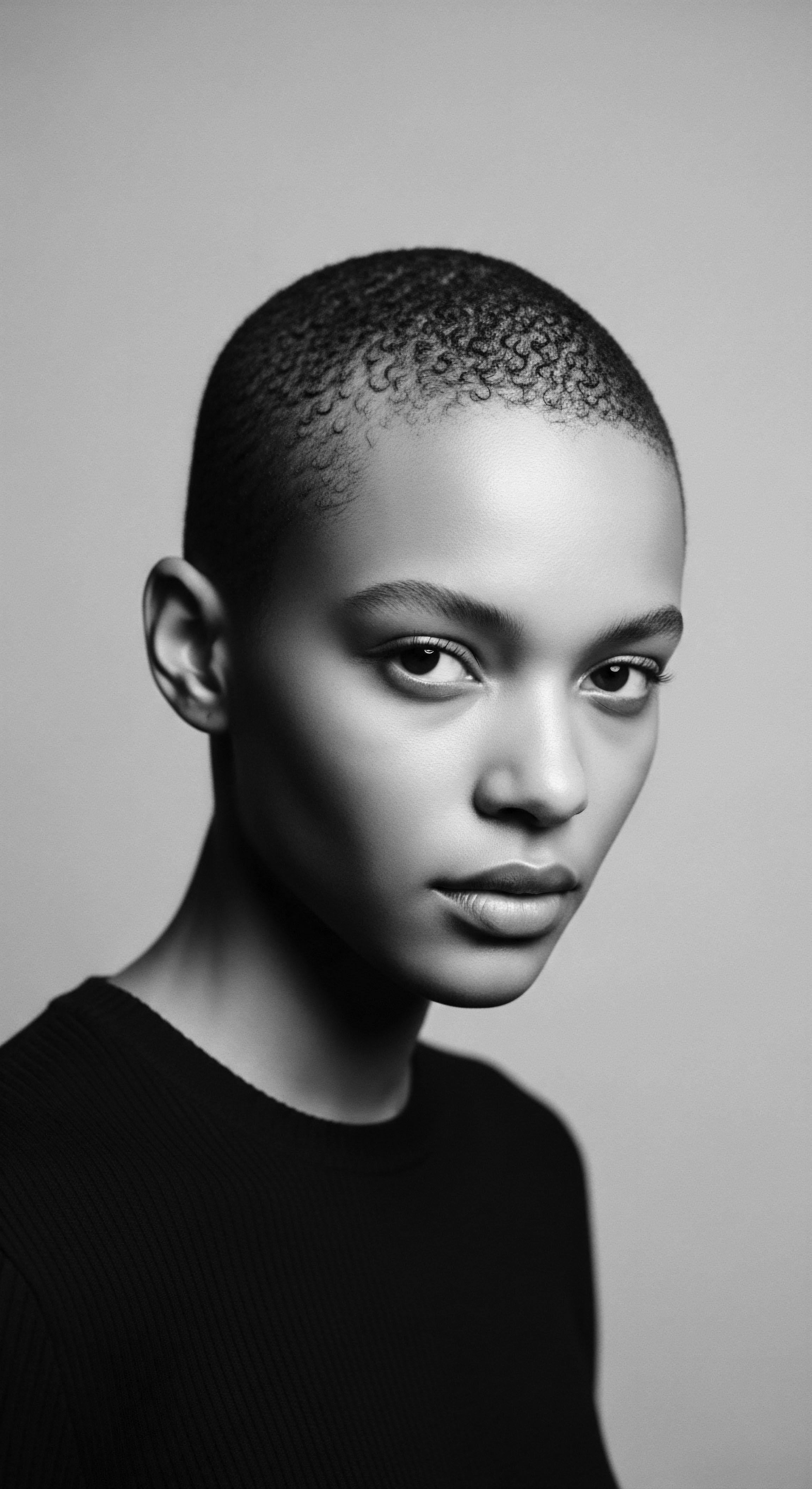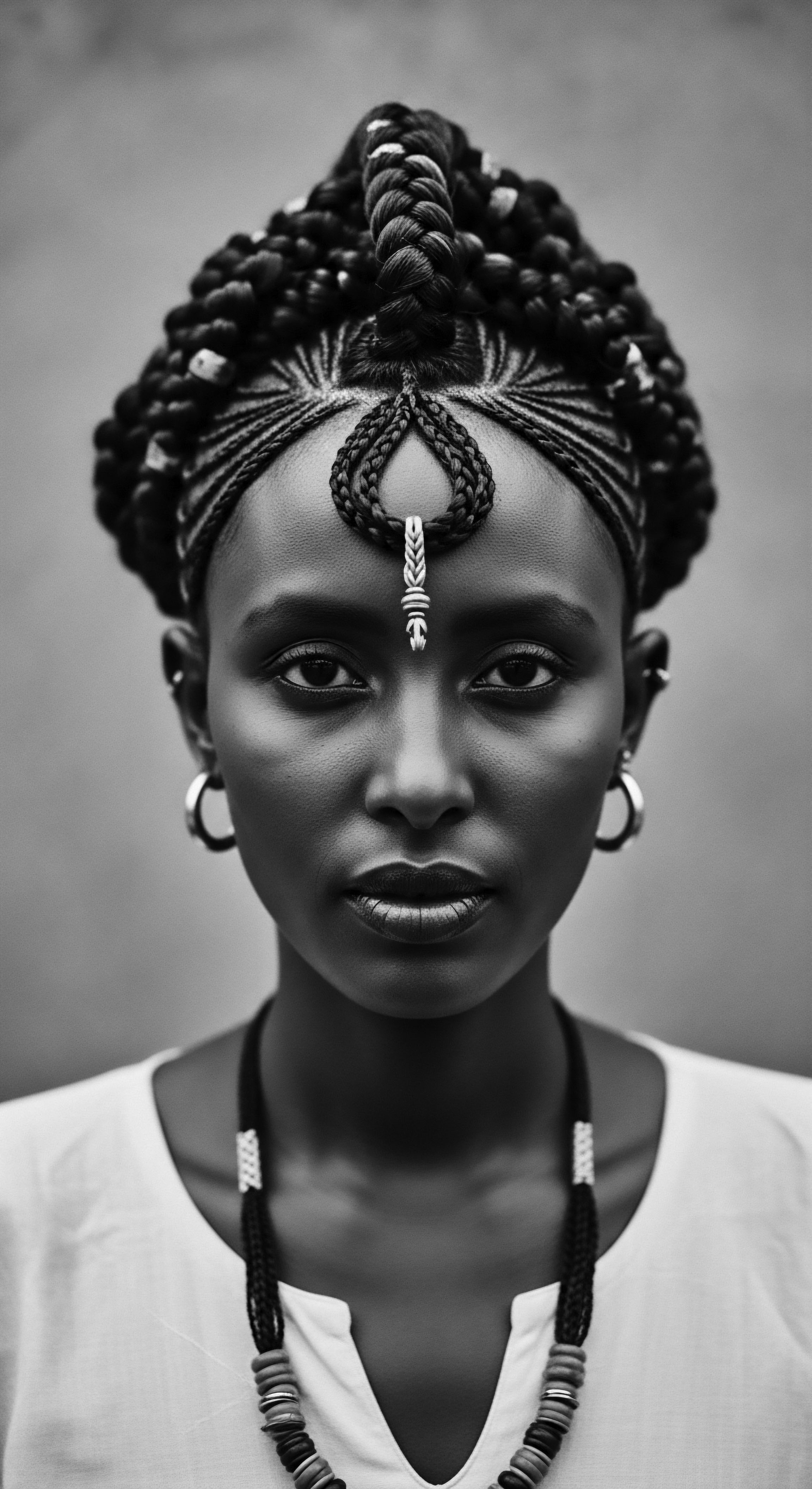
Roots
There exists a profound connection between the earth’s ancient wisdom and the living vitality of textured hair. Consider the remarkable story of rhassoul clay, a geological marvel unearthed from the Atlas Mountains of Morocco. Its very genesis, a slow unfolding over millions of years, speaks to a patience that mirrors the growth of a strand, a deep, persistent rhythm.
For countless generations, this singular mineral has been a silent partner in the meticulous care of hair, particularly within communities whose lineages trace back to these very lands and beyond. To understand its enduring place in our hair heritage, we must first look to the clay’s geological heart, then recognize how ancient hands intuitively grasped its profound properties.
The geological formation of rhassoul, or ghassoul as it is also known, is a testament to primal forces. It is a smectite clay, a type of phyllosilicate mineral that forms through the hydrothermal alteration of volcanic ash. Deep within the earth, under specific conditions of heat and pressure, the ash transforms, giving rise to layers rich in magnesium, silicon, and potassium. This unique mineralogical makeup is precisely what granted rhassoul its remarkable capabilities, long before modern chemistry could name them.
Its extraordinary absorptive power, gentle cleansing action, and softening properties derive directly from this mineral rich composition. Ancestors understood this through observation and generations of practice, perhaps not with electron microscopes but with hands that felt its silkiness, eyes that noted its cleansing efficacy, and hair that responded with unparalleled softness. This ancient mineral, sculpted by elemental forces, became a vessel for ancestral knowledge regarding hair health and beauty.

How Did Ancient Cultures First Discern Rhassoul’s Hair Benefits?
The discovery of rhassoul’s utility for hair was not an accident but a testament to keen observation and iterative practice by early North African and Berber communities. Picture women by mountain streams, witnessing how the clay naturally purified water, how it felt on their skin, and how it transformed their textiles. Such direct interaction, over millennia, led to its dedicated application in personal care. These early adapters understood that certain soils had a particular gift for cleansing without stripping, for conditioning without heavy residue.
It speaks to a deep, intergenerational knowing that pre-dates formal scientific inquiry, a wisdom passed down through touch, demonstration, and observation. The very way a mother taught her daughter to mix the clay, to feel its consistency, to apply it with deliberate strokes—this was the original pedagogy of rhassoul. It was a practice rooted in intimate familiarity with the natural world and a recognition of what worked best for their hair, often of a texture that demanded particular care to retain moisture and definition.
Rhassoul clay’s unique mineral composition, forged over millennia, laid the elemental foundation for its ancestral adaptation in textured hair care.
The relevance of rhassoul clay today for textured hair heritage lies in its intrinsic properties, which mirror the very needs of these hair types. Textured hair, by its nature, often possesses a lower cuticle count and a more elliptical shaft, making it prone to dryness and breakage if not handled with care. Rhassoul, with its saponin content, offers a gentle cleanse that respects the hair’s natural oils, a stark contrast to harsh modern detergents. Its conditioning qualities contribute to slip, aiding in detangling—a centuries-old challenge for coily and kinky hair.
The ancestral adaptations of using rhassoul clay were not simply about cleansing; they represented a profound understanding of how to maintain hair integrity in challenging environments, preserving its strength and luster. This is why it still holds sway; it speaks to a biological need understood through historical practice.
| Traditional Property Observed Cleansing efficacy without lather. |
| Modern Scientific Understanding High cation exchange capacity and negatively charged minerals absorb impurities and oils. |
| Traditional Property Observed Softening and conditioning feel. |
| Modern Scientific Understanding Rich in magnesium, silica, potassium, which can bind to hair, improving elasticity and reducing frizz. |
| Traditional Property Observed Detangling ease and slip. |
| Modern Scientific Understanding Creates a smooth, slippery texture when hydrated, helping to release knots in coily strands. |
| Traditional Property Observed Mineral replenishment for vitality. |
| Modern Scientific Understanding Provides essential minerals that hair and scalp may benefit from, supporting overall scalp health. |
| Traditional Property Observed The enduring utility of rhassoul clay for textured hair finds grounding in both time-honored observation and contemporary scientific validation. |

Ritual
The journey of rhassoul clay from the earth to our textured strands is more than a simple application; it is a continuation of ancestral rituals, a tender thread connecting us to past generations. Its place in hair care, particularly for those with coily, kinky, and wavy textures, transcends mere product use, embodying a practice that speaks to continuity, community, and self-reverence. The traditional use of rhassoul was often woven into the very fabric of daily life and special occasions, a testament to its integral role in personal grooming and cultural expression .
In North African households, especially among Berber women, preparing rhassoul was itself a ritual. The dry clay, often stored in large, cool containers, would be carefully broken into pieces, then mixed with warm water, sometimes infused with aromatic herbs or essential oils native to the region, such as argan oil or rosewater. The clay would swell, transforming into a smooth, silken paste, ready to envelop hair and skin.
This act of mixing was not simply utilitarian; it was a moment of connection, a mindful preparation for a purifying and nourishing experience. The rich scent of the damp earth, blended with botanicals, created a sensory immersion that spoke directly to a holistic approach to wellbeing, a tradition that saw hair care as an extension of spiritual and physical harmony.

How Did Rhassoul Clay Shape Traditional Hair Care Rhythms?
The integration of rhassoul into traditional hair care rhythms reveals its deep ancestral adaptation. Unlike the daily shampooing prevalent in many modern societies, traditional hair cleansing with rhassoul was often a less frequent, more significant event. This rhythm suited textured hair, which benefits from gentle cleansing and retained moisture. The clay’s ability to clean without stripping meant that hair could go longer between washes without becoming overly dry or brittle.
This was especially important in arid climates where water might have been a precious resource, and harsh detergents could wreak havoc on delicate hair structures. The deliberate, measured pace of these cleansing rituals fostered patience and a deep appreciation for natural ingredients. Women would gather, often sharing stories and laughter as they helped one another apply the clay, turning a personal care routine into a communal act, reinforcing bonds of kinship and shared heritage.
The preparation and application of rhassoul clay historically transcended mere cleansing, forming a communal and mindful ritual deeply ingrained in cultural practice.
The methods of applying rhassoul varied but consistently prioritized care and efficacy. After dampening the hair, the smooth clay paste would be massaged onto the scalp and distributed throughout the strands. The clay’s inherent slipperiness aided in detangling, a time-consuming but vital step for textured hair. Unlike modern conditioners, rhassoul would simultaneously cleanse and condition, drawing out impurities while coating the hair shaft with beneficial minerals.
After a period, often fifteen to thirty minutes, the clay would be rinsed, revealing hair that felt remarkably clean, soft, and voluminous. This single-step cleansing and conditioning process, honed over generations, speaks to an ancestral ingenuity that sought efficiency without compromise, providing comprehensive care from a single, abundant source.
- Ghassoul Application ❉ Traditionally mixed with warm water or herbal infusions to form a smooth paste, then applied to damp hair and scalp.
- Communal Cleansing ❉ Often performed in hammams or shared domestic spaces, fostering community and the sharing of hair care knowledge.
- Natural Conditioning ❉ The clay’s mineral content, especially magnesium, provided conditioning without the need for additional products, preventing dryness in coily textures.
The relevance of these rituals persists today. Many individuals with textured hair still seek alternatives to conventional shampoos that can strip natural oils. Rhassoul offers a return to a more gentle, ancestral method of cleansing that respects the hair’s inherent moisture balance.
The feeling of the clay on the scalp, the subtle earthy aroma, the softness it imparts—these sensations echo across time, allowing contemporary users to connect with a practice that nurtured their ancestors’ hair. It’s not simply about the product; it’s about the conscious choice to align one’s care regimen with a legacy of natural self-care, honoring the wisdom embedded in these time-honored cleansing practices.

How Does Rhassoul Inform Modern Hair Practices?
The ancestral adaptations of rhassoul clay directly inform modern natural hair practices. For instance, the growing preference for “co-washing” or low-lather cleansing in textured hair communities finds a direct historical parallel in rhassoul’s gentle, non-foaming cleansing action. Many modern formulations aim to emulate the slip and conditioning aspects that rhassoul naturally provides, albeit often with synthetic polymers. The clay’s historical role as a versatile, all-in-one cleanser and conditioner has, perhaps subconsciously, shaped the desire for multi-benefit products in today’s market.
Moreover, the emphasis on scalp health, a central tenet of rhassoul use, has re-emerged as a crucial element in contemporary hair regimens. This return to natural, simple ingredients, and holistic care routines demonstrates a cyclical relationship between ancient wisdom and current innovation , where the ancestral becomes a blueprint for the modern.

Relay
The enduring wisdom of rhassoul clay, passed through generations, continues its quiet relay in the textured hair landscape of today. It carries not just its chemical efficacy but also the resonant echoes of ancestral resilience, a story whispered through strand and scalp. This ancient adaptation, refined over centuries within North African communities, remains acutely relevant, speaking to the specific needs of textured hair, honoring the historical significance of hair care within Black and mixed-race experiences, and providing a tangible link to ancestral practices in a contemporary world. Its presence in our regimens is a conscious act of remembrance, a bridge between epochs, celebrating continuity.
To truly grasp its enduring relevance, we must consider the specific biological characteristics of textured hair. Its varied curl patterns, from waves to tight coils, often create challenges with moisture retention and detangling. The natural oils produced by the scalp struggle to travel down the spiraled shaft, leading to dryness and susceptibility to breakage. This is where rhassoul clay, with its distinctive properties, proves invaluable.
Its gentle cleansing action, devoid of harsh sulfates, ensures the hair’s natural sebum is preserved, not stripped away. The clay’s mucilaginous quality, when hydrated, offers remarkable slip, facilitating the painstaking but necessary process of detangling tightly coiled hair without undue tension. This protective action, understood intuitively by ancestors who relied on it to maintain healthy hair in often demanding environments, holds just as much weight for individuals navigating modern environmental stressors.

How Does Rhassoul’s Efficacy Connect to Ancestral Practices?
The connection between rhassoul clay’s efficacy and ancestral practices lies in its holistic approach to scalp and hair health . Traditionally, the health of the hair was understood to be inextricably linked to the vitality of the scalp, a concept that modern trichology increasingly validates. Rhassoul’s capacity to draw out impurities and excess oils from the scalp, without causing irritation, directly addresses the delicate balance required for a healthy hair growth environment. It also delivers beneficial minerals such as magnesium and silica, which contribute to hair elasticity and strength.
This deep cleansing and mineralizing action, performed gently, stood in stark contrast to earlier, harsher methods of cleansing, offering a superior alternative that preserved hair integrity. Consider the testimony of M. Belhaj (2007) in Clay Minerals, detailing the historical mining and uses of Moroccan clays, which underscored rhassoul’s traditional economic and cultural significance beyond simple cosmetic application; it was recognized as a valuable resource for overall well-being , including dermatological health. This rigorous historical use suggests a profound understanding of its multifaceted benefits that transcended superficial aesthetics.
Rhassoul clay’s natural properties provide a cleansing and conditioning experience that aligns seamlessly with the fundamental care needs of textured hair types.
The ancestral applications of rhassoul were a form of sophisticated, naturally derived hair engineering, attuned to the hair’s particularities. Unlike many contemporary products that might require multiple steps—shampoo, conditioner, detangler—rhassoul offered a singular, multi-functional solution. This efficiency, born of necessity and deep material knowledge, resonates with today’s desire for streamlined yet effective routines.
For those seeking to minimize chemical exposure or reduce the environmental footprint of their hair care, returning to a pure, earth-derived ingredient like rhassoul is a powerful statement. It is a conscious rejection of often aggressive commercial practices that historically undervalued or misrepresented textured hair, and a reaffirmation of natural, time-tested methods that always honored its unique structure.
- Mineral Absorption ❉ The clay’s unique mineral composition allows it to gently absorb excess oil and impurities from the scalp and hair, promoting a clean environment without stripping essential moisture.
- PH Balance ❉ Rhassoul possesses a natural pH that is compatible with the hair and scalp, contributing to the maintenance of the scalp’s delicate acid mantle.
- Enhanced Elasticity ❉ The presence of key minerals like magnesium and silica may contribute to improved hair elasticity, reducing breakage for fragile textured strands.
Moreover, the relevance of rhassoul clay is deeply interwoven with the socio-cultural fabric of textured hair heritage. For generations, hair has been a potent symbol of identity, resistance, and beauty within Black and mixed-race communities. The deliberate choice to use natural, earth-derived ingredients like rhassoul, mirroring the choices of ancestors, is an act of reclaiming narrative, asserting agency over one’s body and heritage.
It stands as a silent repudiation of colonial beauty standards that often denigrated natural textured hair, offering a pathway to self-acceptance and profound connection to lineage. This return to natural practices represents a conscious decision to value inherited wisdom over externally imposed ideals, allowing individuals to voice their identity through their hair with clarity and authenticity.

How Does Rhassoul Support Contemporary Textured Hair Journeys?
Rhassoul clay actively supports contemporary textured hair journeys by offering a tangible link to an authentic, heritage-informed care philosophy . As individuals navigate the often-complex world of natural hair care, seeking products that truly cater to their unique needs, rhassoul provides a historical anchor. Its simplicity and natural efficacy appeal to those who prioritize ingredient transparency and traditional approaches.
For many, integrating rhassoul into their regimen becomes a personal act of cultural affirmation, a quiet nod to the resilience and resourcefulness of their forebears. The tactile experience of mixing and applying the clay, the feeling of its gentle cleanse, and the resulting softness—all these elements provide a profound sensory connection to a continuum of care that spans generations, strengthening the bond between past and present within the individual’s own hair journey.

Reflection
The journey with rhassoul clay, from its ancient origins to its current place in textured hair care, is a powerful meditation on heritage. It speaks to a deep, abiding connection between the earth, human ingenuity, and the profound significance of hair within our collective and individual stories. The ancestral adaptations of this remarkable clay stand not as relics of a bygone era but as living truths, their utility and resonance undiminished by time. They remind us that the most effective solutions often lie in the simple wisdom of the past, in the intimate knowledge of the land, and in the practices passed down from hand to hand, generation to generation.
As we continue to seek ways to care for our textured strands with reverence and understanding, rhassoul clay offers more than just cleansing or conditioning; it offers a conduit. It connects us to the women who first understood its power, to the rituals that shaped communities, and to a lineage of resilience and beauty that has flowed through centuries of Black and mixed-race experiences. Each application becomes a quiet act of honoring, a recognition that the strength and vibrancy of our hair are deeply rooted in the past, yet vibrantly alive in the present. This ancient clay, truly, remains a profound whisper from the source, guiding us towards a holistic, heritage-centered approach to hair wellness, confirming that the soul of a strand is forever bound to the wisdom of its ancestry.

References
- Belhaj, M. (2007). Moroccan Clays ❉ Origin, Properties, and Industrial Uses. Clay Minerals, 42(3), 369-378.
- Brown, T. T. (2020). The Curly Girl Handbook ❉ A Guide to Coily, Kinky, & Wavy Hair. Black Hair Matters Press.
- Chappell, E. (2012). Hair Stories ❉ Unearthed Narratives of Black Women’s Hair in America. University of Pennsylvania Press.
- Gale, R. (2015). African Hair ❉ Fashion, Beauty, and Culture. Bloomsbury Publishing.
- hooks, b. (1992). Black Looks ❉ Race and Representation. South End Press.
- Jackson, A. T. (2018). The Science of Black Hair ❉ A Comprehensive Guide to Textured Hair Care. Atlanta, GA ❉ T. Jackson.
- Nascimento, M. R. (2019). Cultural Connections ❉ Hair and Identity in the African Diaspora. University of California Press.
- Opoku, A. (2010). Natural Hair Care ❉ A Comprehensive Guide to Healthy Natural Hair. Self-Published.
